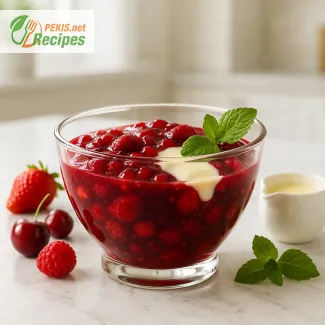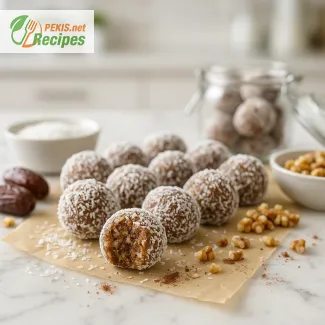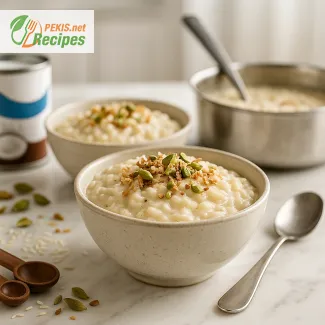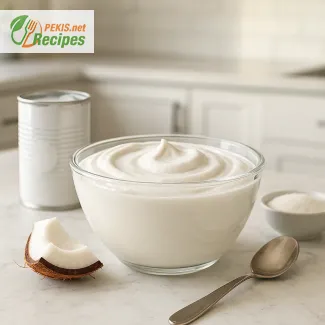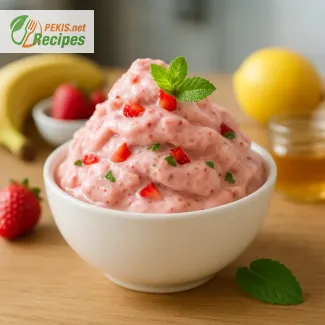
Irresistibly Refreshing: A Frozen Delight for Warm Days
Light, creamy, and perfectly chilled – the ultimate summer dessert inspiration
When the temperature rises and the sun lingers high in the sky, there's nothing more satisfying than indulging in a frozen dessert that cools the body and awakens the senses. Whether you're relaxing in your garden, entertaining guests outdoors, or looking for a sweet escape from the heat, a homemade frozen treat delivers the perfect blend of refreshment, simplicity, and flavor. This frozen dessert recipe is a tribute to summer indulgence – combining smooth textures, natural sweetness, and a chill that revives your energy.
Unlike store-bought options filled with artificial flavors and preservatives, crafting your own cool dessert at home allows you to control the ingredients, customize the taste, and explore a variety of textures – from creamy to crunchy, fruity to nutty. Whether you’re making a frozen yogurt parfait layered with berries, a tropical ice cream blend, or a citrusy sorbet with a zesty twist, this recipe opens the door to endless variation. It’s versatile enough for casual weekday enjoyment and elegant enough for summer gatherings.
Why frozen desserts are perfect for summer enjoyment
Frozen desserts aren’t just treats – they’re temperature therapy for the soul. As the days stretch longer and the heat intensifies, your body craves not only hydration but also food that cools from the inside out. Ice-based or cream-based creations serve this purpose beautifully, delivering both texture and relief. From soft-serve consistencies to layered frozen cakes, they bring joy and comfort while being inherently seasonal and practical.
Homemade frozen desserts also create an opportunity to use fresh summer ingredients at their peak. Ripe fruits like mangoes, strawberries, blueberries, and watermelon not only contribute natural sweetness but also enhance the visual appeal of your creation. Herbs such as mint or basil can add depth and unexpected aromatic contrast, while nuts or seeds provide crunch and balance.
Ingredients that make the difference
The secret to an exceptional frozen dessert lies in the quality of the base ingredients and the balance between creaminess and ice content. A smooth consistency often begins with a yogurt or cream base, sometimes blended with frozen bananas for a natural thickener. Sweeteners can be adjusted depending on preference – from classic sugar or honey to agave syrup or maple syrup for deeper flavor notes.
Flavor layering is another important element. Think of swirls of berry coulis, a drizzle of dark chocolate, or a hint of vanilla bean to bring richness and complexity. Texture contrast matters too – crushed cookies, toasted coconut, or chocolate chips can turn a basic frozen mixture into a sophisticated dessert experience. Using ingredients with low water content helps prevent ice crystals and maintains that smooth, scoopable texture many desire.
Serving and presentation tips to elevate your dessert
Presentation plays a key role in turning a simple recipe into a memorable moment. Serving a frozen dessert in chilled glassware, topped with fresh fruit or a sprig of mint, instantly upgrades the experience. Consider layering components in a tall glass or serving individual portions in small bowls for a cleaner, more refined appearance.
Garnishes not only beautify the final dish but also introduce contrast in color and texture. For example, a berry frozen yogurt can be paired with a crispy almond crumble; a tropical coconut sorbet might benefit from a thin slice of grilled pineapple or passion fruit pulp. These visual and sensory contrasts make the dessert more appealing, especially during hot weather when appetite is often subdued.
Benefits of preparing it in advance
Another perk of frozen desserts is their make-ahead convenience. Preparing your dessert a day or two in advance allows flavors to deepen and meld. It also means you're not scrambling on the day of a gathering. Simply pull your masterpiece from the freezer, add the final garnishes, and you have a show-stopping dessert ready to impress.
Frozen treats also store well, making them ideal for batch preparation. Whether you’re planning a backyard party or simply want to keep something cold and sweet in your freezer for spontaneous cravings, this dessert format is both practical and indulgent. Stored in airtight containers, your frozen creation can retain flavor and texture for several days without compromising quality.
Seasonal flavors and trending combinations
Each summer brings a wave of new flavor trends, and staying adventurous in your combinations keeps things exciting. This year, tropical fusions like mango-lime, coconut-pineapple, or lychee-raspberry are gaining popularity. At the same time, nostalgic classics such as cookies and cream or chocolate-vanilla swirl remain favorites for all age groups.
Modern versions of frozen desserts now often incorporate plant-based alternatives such as almond milk, coconut cream, or oat yogurt, offering a dairy-free option that doesn't sacrifice taste. These variations appeal not only to those with dietary needs but also to food lovers who appreciate the nuanced taste of non-dairy bases.
The versatility of this frozen dessert recipe means you can adjust it for any flavor profile or dietary preference, turning it into a staple of your summer menu. Whether you want something fruity, chocolatey, or tangy, the adaptable nature of the recipe ensures it never goes out of style.
- In a blender, combine Greek yogurt, honey, frozen banana slices, lemon juice, and vanilla extract.
- Blend until smooth and creamy. Scrape down sides to ensure even texture.
- Gently fold in the chopped strawberries and chopped mint leaves with a spatula. Do not blend to keep texture.
- Transfer the mixture into a freezer-safe container and smooth the surface.
- Cover and freeze for at least 3 hours or until firm.
- Before serving, let the dessert sit at room temperature for 5–10 minutes for easier scooping.
- Serve in chilled bowls or glasses and garnish with fresh mint or additional strawberry slices.
Transforming a Classic Frozen Treat into a Flavorful Summer Masterpiece
Smart upgrades, ingredient swaps, and common pitfalls to avoid
Frozen desserts are a timeless solution to beating the heat, but even the most refreshing classic recipes can benefit from thoughtful tweaks. By understanding how individual ingredients influence texture, flavor, and nutritional balance, you can elevate a simple frozen yogurt bowl into a truly memorable summer experience. Whether you’re aiming for a creamier mouthfeel, a stronger fruit presence, or a healthier composition, subtle changes can make a big impact.
Enhancing creaminess and structure
One of the most common goals when adjusting a frozen dessert recipe is achieving a smoother, creamier texture. To enhance the creaminess without adding excessive fat, consider replacing part of the yogurt with coconut cream or mascarpone. These add a luxurious mouthfeel and a delicate flavor that complements the natural sweetness of strawberries and bananas.
For those who prefer a plant-based version, full-fat coconut yogurt or oat yogurt are ideal substitutions. They not only provide richness but also bring unique notes to the flavor profile. Avoid low-fat yogurts, which often result in an icy or chalky texture when frozen.
Another useful trick is to incorporate a small amount of glucose syrup or glycerin—commonly used in professional kitchens to improve scoopability and prevent ice crystals. Just a teaspoon can help maintain a soft, velvety consistency even after extended freezing.
Intensifying fruit flavors
While the original recipe uses strawberries and banana for a naturally sweet and fruity foundation, the intensity of flavor can be enhanced with a few simple steps. Roasting strawberries before blending them releases deeper, caramelized notes, giving the dessert more complexity. Adding a small pinch of salt to the fruit mixture also helps amplify the natural sweetness.
For more adventurous palates, try combining strawberries with tart fruits like passion fruit or blood orange to create contrast. A swirl of homemade berry coulis folded into the yogurt base before freezing adds bursts of concentrated flavor in every bite and makes the presentation more dynamic.
Boosting nutrition with healthy additions
One of the major benefits of homemade frozen desserts is the ability to control the nutritional content. To make the recipe more nutrient-dense, consider adding a tablespoon of chia seeds or ground flaxseeds. These ingredients blend in seamlessly and contribute essential omega-3 fatty acids, fiber, and a mild nutty taste.
Another smart addition is a spoonful of nut butter—like almond or cashew—for a boost of healthy fats and plant-based protein. It introduces a creamy depth and helps make the dessert more satisfying without compromising its refreshing character.
Instead of honey, which has a distinct flavor and a higher glycemic index, maple syrup or date syrup can be used as a lower-fructose alternative with rich, earthy undertones. These natural sweeteners are especially suitable for those looking to reduce refined sugar intake.
Presentation tips that enhance taste and texture
Frozen desserts aren’t just about taste—they’re a visual and tactile experience. By layering textures, you can transform a simple recipe into something worthy of a dinner party. Add a sprinkle of toasted nuts, granola, or dark chocolate shavings just before serving. These toppings offer crunch and contrast, turning each bite into a multi-dimensional treat.
Using frozen fruit pieces (such as diced mango, blueberries, or cherries) adds both color and variety. However, it’s important to fold them in after blending to avoid overprocessing and preserve their texture.
Mistakes to avoid when preparing frozen desserts
Even the simplest frozen recipes have their challenges. A common issue is over-blending, which can cause the dessert to become watery or too soft, especially when working with high-water-content fruits like strawberries. To prevent this, use frozen banana slices instead of fresh ones and always blend in short pulses, checking the consistency regularly.
Another mistake is placing the dessert directly into the freezer without stirring or smoothing. For best results, spread the mixture evenly in a shallow container to allow faster freezing and reduce the formation of large ice crystals. Cover tightly to prevent the absorption of other freezer odors.
Don’t forget to taste the base before freezing. Cold temperatures dull the perception of sweetness, so if the mixture tastes only mildly sweet at room temperature, it may seem underwhelming once frozen. Adjust with a touch more sweetener or fruit puree if needed.
Why homemade always wins
Making your own frozen dessert at home means more than just saving money—it’s about personalization and purity. Commercial frozen yogurts often contain stabilizers, emulsifiers, and artificial flavors. With homemade, you control every element, from sweetness levels to dietary requirements, ensuring a dessert that’s both satisfying and better for your body.
You can also customize batch sizes based on occasion, avoiding waste and unnecessary packaging. Most importantly, creating this dessert yourself connects you with the seasonal ingredients you use, encouraging conscious eating and creativity in the kitchen. The result is a dessert that’s not only delicious but aligned with your preferences, values, and health goals.
Allergens present in the recipe:
- Milk (Greek yogurt)
Contains gluten:
- No
Substitution tips to remove allergens and gluten:
- Replace Greek yogurt with plant-based coconut yogurt for a dairy-free version.
- Ensure honey is replaced with agave syrup for a vegan alternative.
- All other ingredients are naturally gluten-free and allergen-safe when verified.
Vitamins and minerals per serving (approximate):
- Vitamin C: 32 mg – supports immune function and skin health
- Vitamin B6: 0.3 mg – helps regulate metabolism and mood
- Calcium: 120 mg – important for bone health
- Potassium: 310 mg – aids in muscle function and fluid balance
- Magnesium: 22 mg – contributes to nerve function and energy production
Antioxidants per serving (approximate):
- Anthocyanins (from strawberries): 80 mg – protect against oxidative stress and support heart health
- Flavonoids (from mint): 12 mg – reduce inflammation and support brain function
- Polyphenols (from honey and banana): 25 mg – help lower blood pressure and combat aging effects
